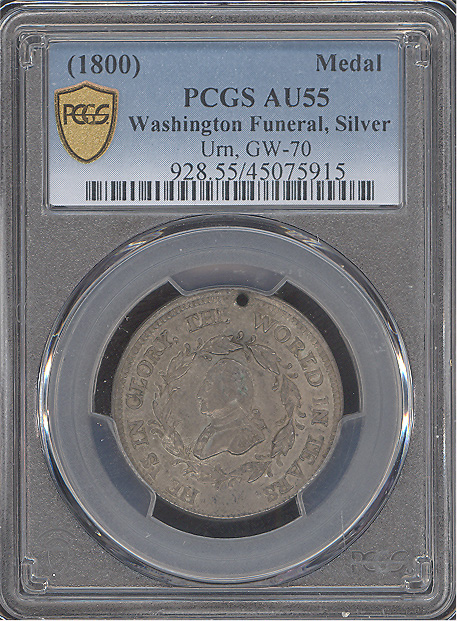They say good things come to those who wait and in numismatics, a case can be made for the 1912-S Liberty Head “V Nickel” 5 cent piece. This key date of the Liberty Head nickel series almost never happened. Coinage finally commenced on Christmas Eve in 1912 and lasted only 4 days. This would be the last year of the Liberty Head nickel series (if you don’t count the 1913 and you shouldn’t).

The San Francisco mint produced a total of just 238,000 V nickels in 1912, making it the lowest mintage of the series by a long shot. Put into perspective, the key date 1885 and 1886 nickels had mintages in the millions but the 1912-S nickel had about half the mintage of the celebrated key date 1909-S VDB Lincoln Cent. Despite a very low mintage, this rarity can be found without too much difficulty in grades up to MS65. In MS66, however, this date becomes truly rare. There are no known MS67’s at either grading service. 10 MS66+’s exist, although some of those are possibly resubmissions.
Quality was indeed a bit of an issue as can be seen by comparing the Philadelphia and Denver mints issues of that year. The Philly and Denver strikes were much crisper. The San Francisco nickels can be seen with a softer overall appearance and weakness on the left side ear of coin on the reverse. On many specimens, the ear is completely flat. You can also expect to encounter die cracks on many specimens as the hardness of the metal wreaked havoc on several sets of dies.
A good example of strike weakness. This coin is graded MS64 by PCGS.
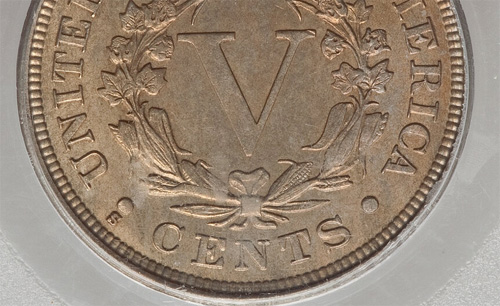
Quality issues aside, this low mintage date did not stimulate much interest at the time. The 1912-S nickel was not alone, however; later in the decade the 1916-D Mercury Dime would be born with a mintage of 264,000 – the lowest of the series and instant key date. This coin too would not be met with much interest. As a whole, mint marks did not hold much importance to collectors until nearly 20 years later. Oh, to be able to go back in time!
Not sure if production was Dec 24 or Dec 26 as the daily logs were not clear.
I have it as 100,000 on December 26 and 138,000 on December 30.
Regardless, they only minted these on 2 days over the last week of 1912.
The following was written by Brian.
Back to Baltimore! The Whitman show is almost always a good one for us and conveniently situated on the east coast, close to home. Unfortunately we needed to fly into DC instead of BWI and that is about a one hour drive from the airport into the city. Still, the weather was nice when we arrived and our flight was only about an hour late; Christmas in June! In addition to the usual gang of Tom, Chris and Brian, our new superstar intern Frank made the trip along with us and he handled the entire show like an old pro. It was great to have him with us.
The next night saw a thunderstorm so intense it knocked the Baltimore Orioles clear into dead last place. Seriously, it was scarier than their staff ERA.
But the next day was really nice!
The dealer pre-show trading was brisk and we were able to make quite a few purchases while moving some of our older inventory at the same time. The rest of the show was also quite good for buying and this is of course great news for our customers.
The show opened the next day and the bourse floor was, ummm, how to put this…roomy! Plenty of space in the aisles to walk and plenty of space behind the booths from which to operate. All this is nice, however, this just meant less tables than in previous shows. The show attendee traffic was light to say the least and there wasn’t much of a ‘buzz’ in the room, but this did not prevent us from doing some solid business! Plenty of fresh coins were offered to us and we’re still in the process of listing them on our site, so be on the lookout in the coming weeks.
Though the dinner dining choices were somewhat mundane this time (we sure do go to Cheesecake Factory a LOT), we did find a nice new Alehouse across the street from the convention center for lunch (no, we did not get any ale for lunch…this time…). We’ll be sure to go back there next time we’re in town.
The following was written by Brian.
The 1918/7-S Standing Liberty quarter deserves a standing ovation. It is without question one of the most heralded rarities in all of numismatics. The fact that it is such an elusive coin coupled with the fact that it is an issue in which the overdate is clear to the naked eye certainly bolster the popularity of this issue.
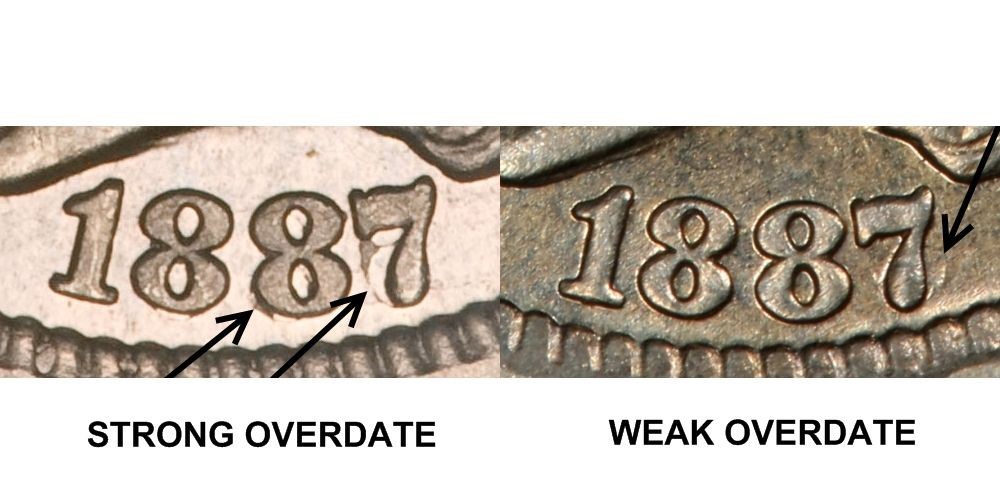
This error occurred as a result of a die blank being first impressed with a hub dated 1917 and then receiving a second impression from one dated 1918. It was then by chance that this die was then stamped with an S mintmark for shipment to San Francisco. It is a matter of debate as to whether or not this die would still have been used even if detected by the San Francisco engraving department.
The 1918-S Standing Liberty Quarter enjoyed a rather large mintage of 11,072,000 and they would be pressed into service immediately. The war years saw a great demand for fresh coinage and this meant there would not be an abundance of rolls to search through once the variety was even discovered. Since coin collecting and hoarding didn’t really become a “thing” in the US until the 1930’s, this variety sat undetected. As with all coin issues pressed directly into circulation, this will mean mint state and high end AU examples will be a challenge.
A tough enough coin to locate in any grade, in mint state, this coin becomes exceedingly difficult. In gem or better, practically impossible, but it can be done, I suppose, with time and (a good deal of) money.
According to the PCGS census, the finest known top out at MS66 (of which there are only two). The PCGS Price Guide for an MS66 1918/7-S Standing Liberty quarter is $125,000. It doesn’t get much easier locating a gem example as PCGS only has 4 (with the Price Guide at $100,000). MS62, 63 and 64 examples are somewhat more plentiful (about 25 in each grade), but they will still cost you a pretty penny. NGC examples are no less scarce. And please keep in mind; the numbers above are for the non-Full Head designated examples. I won’t go into the miniscule populations and inherent price tags for Full Head examples so as not to discourage (perhaps depress) you. I feel that is part of my responsibility as an author.
Ok, the finest known at PCGS are two MS64+ examples – the most recent of which saw an APR of $336,000 in September of 2020.
The good news, as mentioned above, is that this overdate is easily discernable without the need for a loupe. Indeed, even in lower graded examples, it is easy to see and you won’t be disappointed.

With a bit of time and patience (and a few thousand dollars) one can be obtained.
When it comes to Colonial coins, the 1670’s St. Patrick Coppers are by no means the rarest of the bunch. Sure, they are rare in their own right and some of the higher AU grades have brought 5 figures and up. What makes them so interesting to me is how they were minted with brass 'splashers'.
We’ll take the St. Patrick’s Halfpenny for example.

The St. Patrick Halfpenny was a milled copper coin minted in the 17th century (exactly when is the subject of much debate) in Ireland, England and Wales. The reverse depicts King David jamming out on the harp, while the obverse is a standing St. Patrick in bishops regalia, driving serpents out of Ireland and into the sea (as the story goes). The majority of these St. Patrick halfpennies are copper coins with a splash of brass minted in two sizes, large and small.
The intention of the ‘splash’ was to cover King David’s crown, giving it the illusion of being gold and thereby adding aesthetic value, though nobody at the time would have expected it to be real gold. The method of transfer for the brass to copper is also unknown although some specimens are so sloppy it is speculated that Jackson Pollock himself may have been hired for that work.
Englishman Mark Newby (aka Mark Newbie) is responsible for bringing the St. Patrick’s copper coinage to America. A devout Quaker, Newby sought to avoid religious persecution by emigrating to Ireland. Shortly after, he along with several other families of the same belief sailed to America. Newby landed in West New Jersey and established himself as a banker in Camden. What gives Mr. Newby this interesting footnote in American history is the fact that he brought with him from England enough St. Patrick coppers to facilitate their entry as legal coinage in New Jersey. Indeed there was a pressing need for coinage in the colonies.
What makes this particular ‘splasher’ so impressive is not only the sheer size of the brass splash on the obverse, but the fact that it continues all the way to the reverse. This was a farthing example we had back in December of 2020.

Pretty cool.
The following was written by Brian.
George Washington, the 1st President of the United States died December 14th, 1799 and it was a profound tragedy for the nation. Washington’s memory would be honored via tributes and memorials throughout the United States. Boston, in particular, held three separate memorial processions early in 1800. As part of the processions, mourners would be adorned with newly struck ‘Washington Funeral’ medals.
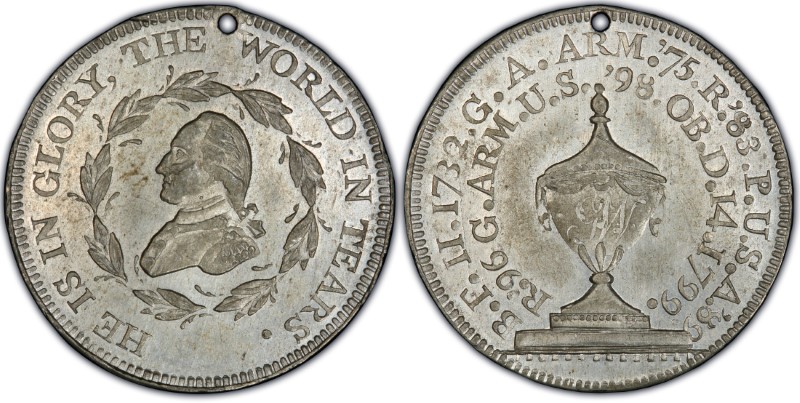
The medals were engraved by Jacob Perkins of Newburyport, Massachusetts. Coincidentally, both Perkins and Washington were masons by trade. The obverse features simply a left facing bust of Washington. Indeed this man was most revered as the obverse legend reads: He is in Glory, The World in Tears. The reverse showcases a funeral urn with ‘GW’ in fancy cursive inscribed on it as well as important dates in Washington’s lifetime. By no means common, these are the most commonly seen Washington Funeral Medals and they were struck in silver, gold, copper and white metal. Though all are rare, the silver and white metal are most frequently encountered while the coppers are rare and the gold medals extremely rare.
As there were to be three different funeral processions in Boston, one medal would be made for each. The first is the aforementioned image above; again Washington bust left with urn on reverse. The second showcases rather jarring imagery (though not uncommon for the time) with skull and crossbones on the reverse. This ‘memento mori’, or mortality reminder is an ancient Masonic emblem.
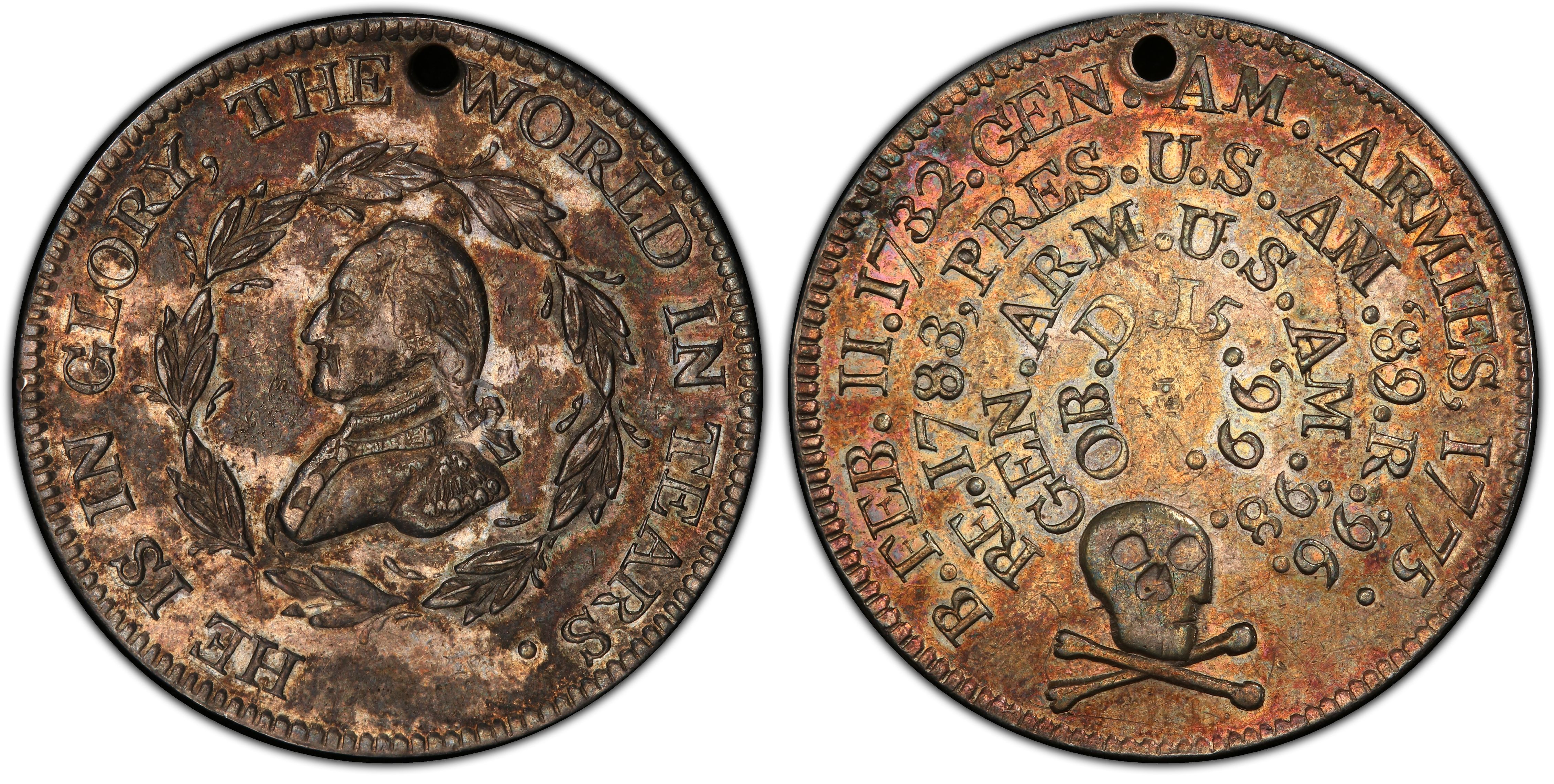
Thirdly, a slight variation of the first medal shown has the GW initials below the urn. Even when compared to the very rare first type, the GW below is a great rarity with only six pieces known.
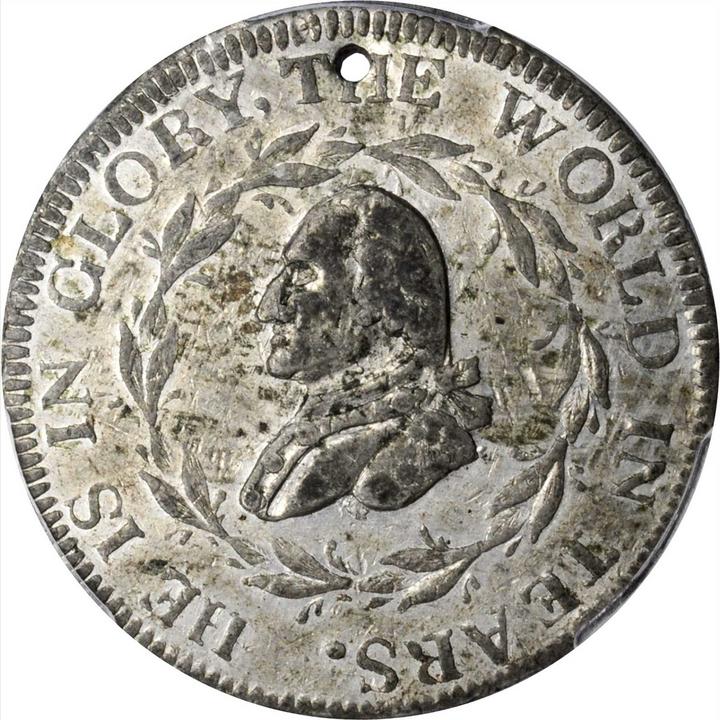
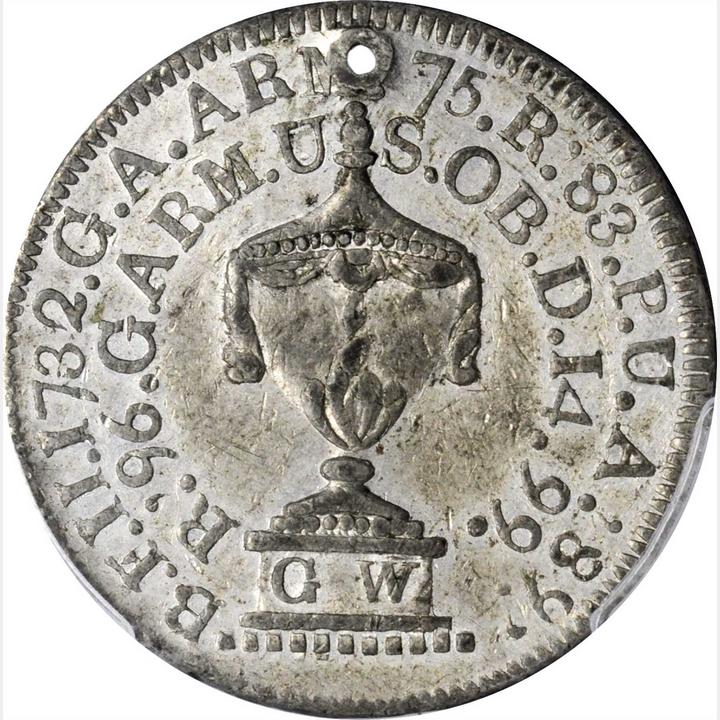

Lastly there exists an oval, uniface medal which is exceedingly rare with likely no more than a dozen specimens struck. This type was not intended to be worn at the processions, per se, but rather to be placed in lockets or in other types of jewelry.
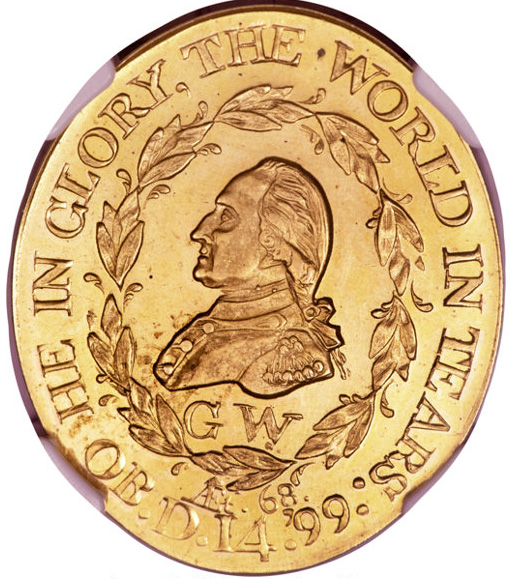
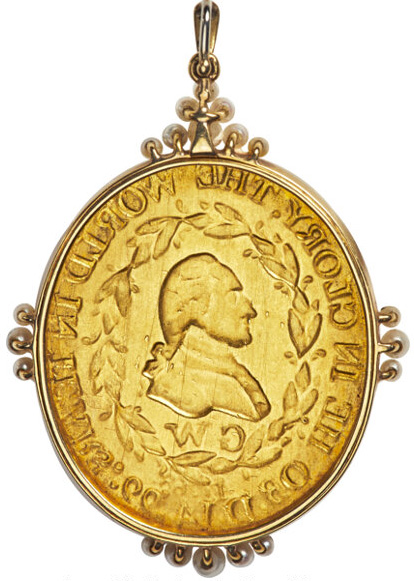
Undoubtedly you’ve noted that all the Washington Funeral medals shown (with the exception of the jewelry piece) are holed. This is because they were all created this way. Now, normally a hole in a coin is a problem. However, not all holes are created equal; these medals were purposely hole-punched because it was required to suspend them. Other holes in coins are indeed considered problems and in most cases lower the value of the coin. This is not the case, however, with the Washington Funeral medal.
Northeast Numismatics is lucky enough to have recently purchased one of these silver medals.
